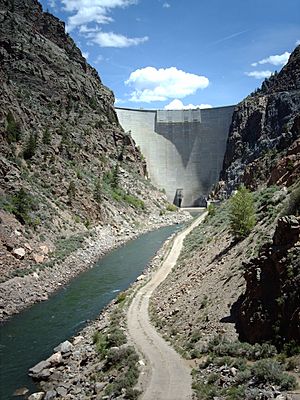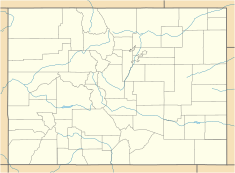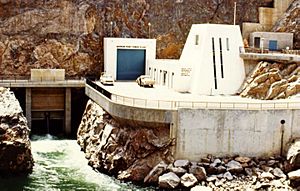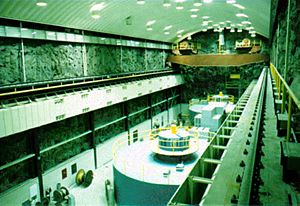Morrow Point Dam facts for kids
Quick facts for kids Morrow Point Dam |
|
|---|---|

Morrow Point Dam
|
|
|
Location of Morrow Point Dam in Colorado
|
|
| Location | Cimarron, Gunnison County, Colorado, USA |
| Coordinates | 38°27′07.25″N 107°32′17″W / 38.4520139°N 107.53806°W |
| Construction began | 1963 |
| Opening date | 1968 |
| Operator(s) | U.S. Bureau of Reclamation |
| Dam and spillways | |
| Type of dam | Concrete thin arch |
| Impounds | Gunnison River |
| Height | 468 feet (143 m) |
| Length | 724 feet (221 m) |
| Width (crest) | 12 feet (3.7 m) |
| Width (base) | 52 feet (16 m) |
| Dam volume | 365,180 cu yd (279,200 m3) |
| Spillway type | Four-orifice free-fall in center of dam face, fixed-wheel gates |
| Spillway capacity | 41,000 cu ft/s (1,200 m3/s) |
| Reservoir | |
| Creates | Morrow Point Reservoir |
| Total capacity | 117,190 acre-feet (0.14455 km3) |
| Catchment area | 3,675 sq mi (9,520 km2) |
| Surface area | 817 acres (331 ha) |
| Power station | |
| Hydraulic head | 413 ft (126 m) |
| Turbines | 2 x 86.667 MW turbines |
| Installed capacity | 173.3 MW |
| Annual generation | 269,193,371 KWh |
The Morrow Point Dam is a huge 468-foot-tall (143 m) concrete dam in Colorado. It's built in a special double-arch shape across the Gunnison River. This dam was the very first of its kind built by the U.S. Bureau of Reclamation.
You can find Morrow Point Dam in the upper part of the Black Canyon of the Gunnison National Park. It creates a lake called Morrow Point Reservoir. The dam and lake are part of the National Park Service's Curecanti National Recreation Area. It sits between two other dams: the Blue Mesa Dam (upstream) and the Crystal Dam (downstream).
Morrow Point Dam is part of a bigger project called the Wayne N. Aspinall Unit of the Colorado River Storage Project. This project helps control the water from the Colorado River and its smaller rivers. This water is used for farms and cities in the American Southwest. The main job of Morrow Point Dam is to create electricity using the power of water.
About the Dam
The dam, its power plant, and the reservoir are all built into very old, strong rocks. These rocks are mostly a type called metamorphic rocks, which are like very tough, layered stone. The dam is in a narrow canyon, about 200 feet (61 m) wide at the river level and 550 feet (170 m) wide at the top.
When extra water needs to be released, it goes through a special spillway. This water falls about 350 feet (110 m) into a pool below the dam. Big tunnels, about 18 feet (5.5 m) wide, take water from the reservoir to the power plant. These tunnels have strong steel linings. The river always has at least 100 cubic feet per second (2.8 m3/s) of water flowing, which is like 200 acre-feet (0.00025 km3) every day.
Building the Dam
The idea for the Curecanti Project, which later became the Wayne N. Aspinall Project, started in 1955. At first, they planned to build four dams. In 1959, the government approved building the Blue Mesa Dam and Morrow Point Dam. The plans for Crystal Dam were finished and approved in 1962. A fourth dam was decided against because it would cost too much.
The project focused on a 40 miles (64 km) stretch of the Gunnison River, just above the Black Canyon of the Gunnison National Park. Work on the dam site began in 1961 with drilling into the ground. In 1962, they dug a test tunnel for the power plant.
The main construction contract for the dam was given to two companies working together: Al Johnson Construction Company and Morrison-Knudsen. They officially started work on June 13, 1963. That year, they began building access roads and a tunnel to redirect the river's water. This diversion tunnel was finished by May 1964. Digging continued on both sides of the dam through 1964.
In 1965, work started on the power plant, with several tunnels being dug. The first concrete for the dam was poured on September 3, 1965. By April 1966, the power plant area was fully dug out. The last concrete for the dam was poured on September 14, 1967. The river's water was sent through the dam's new structures starting January 25, 1968. The dam was officially finished on October 7, 1968, though work on the power plant continued. The power plant and a visitor center were completed in 1971, with everything fully finished by May 12, 1972.
How the Power Plant Works
The Morrow Point Dam's power plant is hidden inside the canyon wall, about 400 feet (120 m) below the surface, near the dam's left side. It holds two large generators, each able to produce 86.667 megawatts (MW) of electricity. These generators were upgraded in 1992-1993 from their original 60 MW capacity.
The main room where the generators are located is 231 feet (70 m) long and 57 feet (17 m) wide, with a height that varies between 64 metres (210 ft) and 134 feet (41 m). The power plant started working in 1970. It mostly operates as a "peaking plant," meaning it generates extra power during times when electricity demand is highest.
During the irrigation season, when farmers need a lot of water, the power plant runs more steadily. At other times of the year, it provides power during peak demand.




